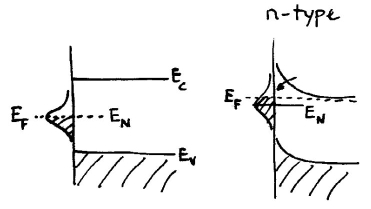
Within SEMITIP, surface states are treated as being completely localized at the surface. They influence the band bending through the charge that they carry, which depends on the position of the Fermi-level. Equilibrium (i.e. same Fermi-level) is assumed between surface and bulk states, and the amount of surface charge varies as a function of the radial coordinate in accordance with the radial dependence of the potential. The SEMITIP program solves for the appropriate electrostatic solution such that the final potential profile together with the resulting surface charge all satisfies Poisson's equation.
In some early treatments of surface charges a single Gaussian band of states was often assumed, as shown below. In the diagram to the left no semiconductor doping occurs; the surface band is filled with electrons up to some energy known as the "charge neutrality level". This is the energy below which states are neutral when filled and positively charged when empty, and above which they are negatively charged when filled and neutral when empty. The former types of states are known, by definition, as donor-like and the latter as acceptor-like. Now, considering n-type doping as shown in the diagram to the right, some electrons from the conduction band are transferred to the surface band (i.e. since it is lower in energy) as depicted by the arrow. The surface band then acquires negative charge, and in the semiconductor there is positive charge (space charge) left behind from the dopant cores where the electrons have left. The resulting potential profile is as shown in the diagram. Similarly on p-type material downwards band bending results, with the Fermi-level ending up slightly below the charge-neutrality level.


Within the SEMITIP program, the surface charge at each value of the radial coordinate is composed of an integral of the states between the charge-neutrality level and the Fermi-level. (NOTE: This formulation of the integral is actually an approximation, applicable to to zero temperature. VERSION 4 and higher of the program provides the possibility of removing this approximation and including an appropriate Fermi occupation factor in the integral, although for most problems the difference is probably not relevant). One other point to note is the possible extension of the surface states up to energies outside the band gap (i.e. resonant with the bulk bands). Whether or not this phycially occurs depends on the surface under study, i.e. depending on the degree of localization of such resonant states near the surface. The surface states are specified in the function SIG at the bottom of the SEMITIP_Vx.F program. For versions V2 and V3, as written, the surface states do extend outside the bandgap. For versions V4 and V5, as written, the surface states also do extend outside the bandgap, although removing the comment indicators from the first few lines in the SIG routines in these versions will restrict the states to exist only within the bandgap.